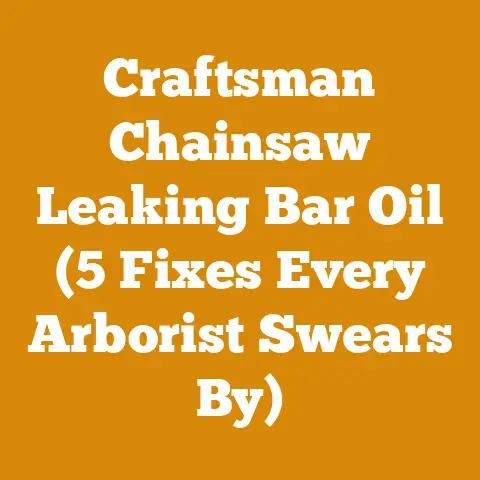Poplar Tree Firewood Guide (Heat & Burning Tips for Woodworkers)
Let’s dive into the world of poplar firewood, but before we do, let’s address the elephant in the room – allergies. As someone who’s spent a good chunk of my life around wood, I know firsthand that allergies can be a real buzzkill. Poplar, while not as notorious as some other woods, can still trigger allergic reactions in sensitive individuals. The pollen, especially during the spring, can be a nuisance, and even the sawdust can irritate the skin and respiratory system. So, if you’re prone to allergies, it’s wise to take precautions like wearing a dust mask and gloves when handling poplar. Now that we’ve got that covered, let’s get into the nitty-gritty of poplar firewood.
Understanding Poplar: A Quick Introduction
Poplar is a fast-growing, relatively soft hardwood. It’s common across North America and Europe, making it readily available in many regions. However, its lower density compared to hardwoods like oak or maple means it produces less heat per volume. This is a crucial factor when evaluating its suitability as firewood.
Poplar’s BTU Rating and Heat Output
The heating value of firewood is typically measured in British Thermal Units (BTUs). BTU measures the amount of heat required to raise one pound of water by one degree Fahrenheit. Poplar typically has a BTU rating of around 12 to 14 million BTUs per cord.
-
Why this matters: A lower BTU rating means you’ll need to burn more poplar to achieve the same level of heat as a higher-BTU wood.
-
Comparison: Oak, a popular choice for firewood, boasts around 20-24 million BTUs per cord. This means oak produces significantly more heat per volume than poplar.
Burning Characteristics: Pros and Cons
Poplar has several pros and cons as firewood:
Pros:
- Easy to Split: Its softer nature makes it incredibly easy to split, even with a maul instead of a powered splitter. This is a huge plus for those who prefer manual firewood processing.
- Quick Drying Time: Poplar dries relatively quickly, often seasoned and ready to burn in 6-12 months, depending on your climate.
- Readily Available and Affordable: In many areas, poplar is abundant and, therefore, more affordable than premium hardwoods.
- Clean Burning (When Dry): Well-seasoned poplar burns relatively cleanly, producing less smoke and creosote buildup compared to unseasoned or softwood.
Cons:
- Lower Heat Output: As mentioned, its lower BTU rating means you’ll need more of it to heat your home.
- Burns Quickly: Poplar burns faster than denser hardwoods, requiring more frequent reloading of your stove or fireplace.
- Can Produce More Ash: Some users report a higher ash content compared to other woods.
- Not Ideal for Cold Climates: In regions with harsh winters, poplar alone might not provide sufficient heat for extended periods.
Seasoning Poplar Firewood: The Key to Efficient Burning
Seasoning is the process of drying firewood to reduce its moisture content. This is crucial for efficient burning and reducing smoke and creosote buildup.
- Target Moisture Content: Aim for a moisture content of 20% or less.
- How to Season:
- Split the wood: Splitting exposes more surface area for faster drying.
- Stack it properly: Stack the wood off the ground, allowing air to circulate freely. Cover the top of the stack to protect it from rain and snow, but leave the sides open for ventilation.
- Location matters: Choose a sunny, windy location for faster drying.
- Drying Time: Poplar typically takes 6-12 months to season properly, depending on your climate and the size of the wood.
- Testing Moisture Content: A moisture meter is an invaluable tool for determining when your firewood is ready to burn. You can find these at most hardware stores.
Identifying Poplar Trees: A Woodworker’s Guide
Being able to identify poplar trees is key to sourcing your own firewood. Here are some key characteristics:
- Leaves: Poplar leaves are typically heart-shaped or triangular, with a slightly toothed edge.
- Bark: The bark of young poplar trees is smooth and greenish-gray. As the tree matures, the bark becomes furrowed and darker gray.
- Shape: Poplar trees are typically tall and straight, with a relatively narrow crown.
- Location: Poplar trees are commonly found in moist areas, such as along rivers and streams.
Harvesting Poplar: Sustainable Practices
If you plan to harvest your own poplar, it’s essential to do so sustainably.
- Check Local Regulations: Before cutting any trees, check with your local authorities to ensure you have the necessary permits and are following all regulations.
- Select Mature Trees: Choose mature trees for harvesting, as they are less likely to be damaged by cutting.
- Leave Seed Trees: Leave some mature trees standing to provide seeds for future generations.
- Avoid Over-Harvesting: Don’t cut more trees than the forest can naturally regenerate.
Safety First: Essential Gear for Handling Poplar Firewood
Working with firewood can be dangerous if proper safety precautions aren’t taken. Here’s a list of essential gear:
- Eye Protection: Safety glasses or goggles are essential to protect your eyes from flying debris.
- Gloves: Wear sturdy work gloves to protect your hands from splinters and cuts.
- Hearing Protection: Chainsaws can be incredibly loud, so wear earplugs or earmuffs to protect your hearing.
- Steel-Toed Boots: Protect your feet from falling logs with steel-toed boots.
- Chainsaw Chaps: If you’re using a chainsaw, wear chainsaw chaps to protect your legs from accidental cuts.
- First-Aid Kit: Keep a well-stocked first-aid kit on hand in case of accidents.
Poplar Firewood: Cost Analysis
Now, let’s get down to the brass tacks: the cost of poplar firewood. This is where things get interesting, as the price can vary wildly depending on several factors. As someone who has bought and sold firewood for years, I can tell you that the market is anything but predictable.
Factors Affecting the Cost of Poplar Firewood
- Location: Prices vary significantly by region. Areas with abundant poplar will generally have lower prices.
- Season: Firewood prices tend to be higher in the fall and winter, when demand is highest. Buying in the spring or summer can often save you money.
- Form: Whether you buy it green (unseasoned), seasoned, split, or in log form will all impact the price.
- Quantity: Buying in bulk (e.g., a full cord) is typically cheaper than buying smaller quantities.
- Delivery: Delivery charges can add significantly to the cost, especially if you live far from the supplier.
- Seller: Prices can vary between different firewood suppliers. It pays to shop around.
Breaking Down the Costs: A Detailed Look
Let’s break down the costs involved in acquiring and preparing poplar firewood. I’ll use data from various sources and my own experience to give you a realistic picture.
1. Timber Purchase or Harvesting Costs
- If you buy the wood: The cost of a cord of poplar firewood can range from $80 to $200, depending on the factors mentioned above. Data from the U.S. Energy Information Administration indicates that the average price of firewood in the Northeast is higher than in the South, reflecting regional differences in demand and supply.
- If you harvest your own: This eliminates the purchase cost but introduces other expenses.
2. Tool Costs
- Chainsaw: A decent chainsaw can cost anywhere from $200 to $800 or more, depending on the brand and features. I recommend investing in a reliable model, as it will save you time and frustration in the long run. I’ve used Stihl and Husqvarna chainsaws for years, and they’ve always served me well.
- Splitting Maul: A good splitting maul can cost around $50 to $100.
- Axe: A quality axe is another essential tool, costing around $40 to $80.
- Chainsaw Sharpener: A chainsaw sharpener is crucial for maintaining your chainsaw’s performance. Manual sharpeners cost around $20 to $50, while electric sharpeners can cost $100 or more.
- Safety Gear: As mentioned earlier, safety gear is essential. Expect to spend around $100 to $200 on safety glasses, gloves, hearing protection, steel-toed boots, and chainsaw chaps.
- Powered Splitter (Optional): If you plan to split a lot of wood, a powered splitter can save you a lot of time and effort. Rental fees typically range from $50 to $100 per day. Purchasing a splitter can cost $1,000 or more.
3. Tool Maintenance Costs
- Chainsaw Maintenance: Chainsaws require regular maintenance, including chain sharpening, oiling, and spark plug replacement. Expect to spend around $50 to $100 per year on chainsaw maintenance.
- Axe and Maul Maintenance: Axes and mauls require occasional sharpening. You can sharpen them yourself with a file or have them professionally sharpened.
4. Labor Costs
- Your Time: Don’t forget to factor in the value of your time. Harvesting and processing firewood can be time-consuming, so consider the opportunity cost of spending that time on other activities.
- Hired Help: If you hire someone to help you, expect to pay them an hourly wage of $15 to $30, depending on their experience and the region.
5. Fuel Costs
- Chainsaw Fuel: Chainsaws require a mixture of gasoline and oil. Expect to spend around $10 to $20 per gallon of fuel.
- Vehicle Fuel: If you’re harvesting your own wood, you’ll need to factor in the cost of fuel for your vehicle.
6. Permits (If Applicable)
- Harvesting Permits: In some areas, you may need a permit to harvest firewood from public lands. The cost of these permits varies by region.
Case Study: Cost Breakdown for a Cord of Poplar Firewood
Let’s look at a hypothetical case study to illustrate the costs involved in preparing a cord of poplar firewood.
Scenario: You decide to harvest your own poplar firewood from a nearby forest.
- Tool Costs (Amortized Over Several Years): $200
- Fuel Costs: $50
- Permit Costs: $25
- Maintenance Costs: $30
- Your Time (20 Hours at $15/Hour): $300
Total Cost: $605
Cost per Cord: $605
In this scenario, the cost of preparing your own poplar firewood is $605 per cord. This is significantly higher than the cost of buying it from a supplier, but it doesn’t factor in the value of the exercise, the satisfaction of doing it yourself, and the potential for saving money in the long run.
Industry Benchmarks and Statistical Data
- Average Price per Cord of Firewood: According to the U.S. Energy Information Administration, the average price of a cord of firewood in the United States ranges from $150 to $400, depending on the region and wood type.
- Equipment Rental Fees: Equipment rental fees for powered splitters typically range from $50 to $100 per day.
- Fuelwood Market Rates: Fuelwood market rates vary by region and wood type. You can find local market rates by contacting firewood suppliers or checking online marketplaces.
Cost Optimization and Budget Management
Here are some practical tips for cost optimization and budget management in wood processing or firewood preparation projects:
- Buy in Bulk: Buying firewood in bulk is typically cheaper than buying smaller quantities.
- Buy Off-Season: Firewood prices tend to be lower in the spring and summer.
- Harvest Your Own Wood: If you have access to a forest and the necessary permits, harvesting your own wood can save you money.
- Maintain Your Tools: Regular tool maintenance can extend the life of your tools and prevent costly repairs.
- Share Equipment: Consider sharing equipment with neighbors or friends to reduce costs.
- Shop Around: Compare prices from different firewood suppliers before making a purchase.
- Season Your Own Wood: Seasoning your own wood can save you money compared to buying seasoned wood.
Calculating Volume: Board Feet and Cords
Understanding how to calculate the volume of logs is essential for accurately estimating the amount of firewood you have.
- Board Foot: A board foot is a unit of measurement for lumber equal to 144 cubic inches (12 inches long, 12 inches wide, and 1 inch thick).
- Cord: A cord is a unit of measurement for firewood equal to 128 cubic feet (4 feet high, 4 feet wide, and 8 feet long).
- Converting Board Feet to Cords: The conversion from board feet to cords varies depending on the species of wood and the size of the logs. As a general rule, it takes approximately 500 board feet of softwood or 300 board feet of hardwood to make a cord of firewood.
Estimating Drying Time: Moisture Content Matters
Estimating the drying time for firewood is crucial for ensuring efficient burning.
- Factors Affecting Drying Time: Drying time depends on several factors, including wood species, log size, climate, and stacking method.
- Moisture Content: The target moisture content for firewood is 20% or less.
- Estimating Drying Time: As a general rule, poplar firewood takes 6-12 months to season properly. However, this can vary depending on the factors mentioned above.
- Using a Moisture Meter: A moisture meter is the most accurate way to determine when your firewood is ready to burn.
Poplar Firewood: A Global Perspective
The use of poplar as firewood varies across the globe, influenced by factors such as climate, availability, and cultural preferences.
- North America: Poplar is a common firewood choice in many parts of North America, particularly in regions where it is abundant.
- Europe: Poplar is also used as firewood in Europe, although it is less popular than other hardwoods like oak and beech.
- Asia: In some parts of Asia, poplar is used as a fuel source for cooking and heating.
Challenges Faced by Small-Scale Loggers and Firewood Suppliers
Small-scale loggers and firewood suppliers face several challenges, including:
- Fluctuating Timber Prices: Timber prices can fluctuate significantly, making it difficult to plan and budget.
- Rising Fuel Costs: Rising fuel costs can eat into profits.
- Competition from Larger Operations: Small-scale loggers and firewood suppliers often face competition from larger operations that can offer lower prices.
- Regulations and Permits: Complying with regulations and obtaining the necessary permits can be time-consuming and expensive.
- Weather Conditions: Weather conditions can impact harvesting and drying times.
Actionable Takeaways and Next Steps
- Assess Your Needs: Determine how much firewood you need to heat your home or power your wood-burning stove.
- Evaluate Your Resources: Consider whether you want to buy firewood or harvest your own.
- Research Local Prices: Contact firewood suppliers in your area to get price quotes.
- Invest in Essential Tools: Purchase the necessary tools, including a chainsaw, splitting maul, axe, and safety gear.
- Season Your Firewood Properly: Allow your firewood to season for at least 6-12 months before burning it.
- Burn Responsibly: Burn only seasoned firewood and follow all safety precautions.
Conclusion: Is Poplar Firewood Right for You?
Poplar firewood has both its advantages and disadvantages. Its easy splitting and quick drying time make it an attractive option for some, while its lower heat output may be a deal-breaker for others. By understanding the factors discussed in this guide, you can make an informed decision about whether poplar firewood is right for you.
Ultimately, the best firewood is the one that meets your needs and fits your budget. Whether you choose poplar or another type of wood, remember to prioritize safety, sustainability, and responsible burning practices. And who knows, maybe you’ll find, as I have, that the process of preparing firewood is just as rewarding as the warmth it provides.






